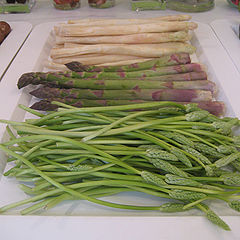Asparagus
| Asparagus | |
|---|---|
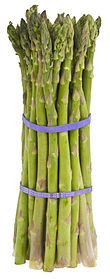 | |
| A bundle of cultivated asparagus | |
Scientific classification | |
| Kingdom: | Plantae |
Clade: | Angiosperms |
Clade: | Monocots |
| Order: | Asparagales |
| Family: | Asparagaceae |
| Subfamily: | Asparagoideae |
| Genus: | Asparagus |
| Species: | A. officinalis |
Binomial name | |
Asparagus officinalis L. | |
Synonyms[1] | |
List
| |

A multitude of cultivated asparagus bundles
Asparagus, or garden asparagus, folk name sparrow grass, scientific name Asparagus officinalis, is a spring vegetable, a flowering perennial plant species in the genus Asparagus.
It was once classified in the lily family, like the related Allium species, onions and garlic, but the Liliaceae have been split and the onion-like plants are now in the family Amaryllidaceae and asparagus in the Asparagaceae. Sources differ as to the native range of Asparagus officinalis, but generally include most of Europe and western temperate Asia.[2][3][4][5] It is widely cultivated as a vegetable crop.
Contents
1 Biology
2 History
3 Uses
3.1 White asparagus in continental northwestern Europe and western Asia
4 Cultivation
4.1 Companion planting
5 Commercial production
5.1 Celebrations
6 Vernacular names and etymology
7 Effects on urine
7.1 Chemistry
8 Gallery
9 Notes
10 References
11 External links
Biology

Asparagus shoot before becoming woody
Asparagus is a herbaceous, perennial plant[6] growing to 100–150 cm (39–59 in) tall, with stout stems with much-branched, feathery foliage. The "leaves" are in fact needle-like cladodes (modified stems) in the axils of scale leaves; they are 6–32 mm (0.24–1.26 in) long and 1 mm (0.039 in) broad, and clustered four to 15 together, in a rose-like shape.[7] The root system is adventitious and the root type is fasciculated. The flowers are bell-shaped, greenish-white to yellowish, 4.5–6.5 mm (0.18–0.26 in) long, with six tepals partially fused together at the base; they are produced singly or in clusters of two or three in the junctions of the branchlets. It is usually dioecious, with male and female flowers on separate plants, but sometimes hermaphrodite flowers are found. The fruit is a small red berry 6–10 mm diameter, which is poisonous to humans.[8]
Plants native to the western coasts of Europe (from northern Spain north to Ireland, Great Britain, and northwest Germany) are treated as Asparagus officinalis subsp. prostratus (Dumort.) Corb., distinguished by its low-growing, often prostrate stems growing to only 30–70 cm (12–28 in) high, and shorter cladodes 2–18 mm (0.079–0.709 in) long.[3][9]
It is treated as a distinct species, Asparagus prostratus Dumort, by some authors.[10][11]
History
 | |
Asparagus has been used as a vegetable and medicine, owing to its distinct flavour, diuretic properties, and more. It is pictured as an offering on an Egyptian frieze dating to 3000 BC. In ancient times, it was also known in Syria and in Spain. Greeks and Romans ate it fresh when in season, and dried the vegetable for use in winter; Roman Epicureans even froze it high in the Alps, for the Feast of Epicurus. Emperor Augustus created the "Asparagus Fleet" for hauling the vegetable, and coined the expression "faster than cooking asparagus" for quick action.[Note 1][13][14]
A recipe for cooking asparagus is in the oldest surviving book of recipes, Apicius's third-century AD De re coquinaria, Book III.
The ancient Greek physician Galen (prominent among the Romans) mentioned asparagus as a beneficial herb during the second century AD, but after the Roman empire ended, asparagus drew little medieval attention.[15][Note 2]
until al-Nafzawi's The Perfumed Garden. That piece of writing celebrates its (scientifically unconfirmed) aphrodisiacal power, a supposed virtue that the Indian Ananga Ranga attributes to "special phosphorus elements" that also counteract fatigue. By 1469, asparagus was cultivated in French monasteries. Asparagus appears to have been hardly noticed in England until 1538,[Note 2]
and in Germany until 1542.[14]
The finest texture and the strongest and yet most delicate taste is in the tips.[16] The points d'amour ("love tips") were served as a delicacy to Madame de Pompadour.[17]
Asparagus became available to the New World around 1850, in the United States.[14]
Uses
| Nutritional value per 100 g (3.5 oz) | |
|---|---|
| Energy | 85 kJ (20 kcal) |
Carbohydrates | 4 g |
| Sugars | 1.88 g |
| Dietary fibre | 2.1 g |
Fat | 0.12 g |
Protein | 2.2 g |
| Vitamins | Quantity %DV† |
Vitamin A equiv. beta-Carotene lutein zeaxanthin | 5% 38 μg4% 449 μg710 μg |
| Thiamine (B1) | 12% 0.143 mg |
| Riboflavin (B2) | 12% 0.141 mg |
| Niacin (B3) | 7% 0.978 mg |
| Pantothenic acid (B5) | 5% 0.274 mg |
| Vitamin B6 | 7% 0.091 mg |
| Folate (B9) | 13% 52 μg |
| Choline | 3% 16 mg |
| Vitamin C | 7% 5.6 mg |
| Vitamin E | 7% 1.1 mg |
| Vitamin K | 40% 41.6 μg |
| Minerals | Quantity %DV† |
| Calcium | 2% 24 mg |
| Iron | 16% 2.14 mg |
| Magnesium | 4% 14 mg |
| Manganese | 8% 0.158 mg |
| Phosphorus | 7% 52 mg |
| Potassium | 4% 202 mg |
| Sodium | 0% 2 mg |
| Zinc | 6% 0.54 mg |
Link to USDA Database entry | |
| |
†Percentages are roughly approximated using US recommendations for adults. Source: USDA Nutrient Database | |
Only young asparagus shoots are commonly eaten: once the buds start to open ("ferning out"), the shoots quickly turn woody.[18]
Water makes up 93% of asparagus's composition.[19] Asparagus is low in calories and is very low in sodium. It is a good source of vitamin B6, calcium, magnesium, and zinc, and a very good source of dietary fibre, protein, beta-carotene, vitamin C, vitamin E, vitamin K, thiamin, riboflavin, rutin, niacin, folic acid, iron, phosphorus, potassium, copper, manganese, and selenium,[20][21]
as well as chromium, a trace mineral that enhances the ability of insulin to transport glucose from the bloodstream into cells.[citation needed] The amino acid asparagine gets its name from asparagus, as the asparagus plant is relatively rich in this compound.
The shoots are prepared and served in a number of ways around the world, typically as an appetizer[22]
or vegetable side dish. In Asian-style cooking, asparagus is often stir-fried. Cantonese restaurants in the United States often serve asparagus stir-fried with chicken, shrimp, or beef. It may also be quickly grilled over charcoal or hardwood embers, and is also used as an ingredient in some stews and soups. In recent years,[when?] asparagus eaten raw, as a component of a salad, has regained popularity.[23]
Asparagus can also be pickled and stored for several years. Some brands label shoots prepared in this way as "marinated".
Stem thickness indicates the age of the plant, with the thicker stems coming from older plants. Older, thicker stalks can be woody, although peeling the skin at the base removes the tough layer. Peeled asparagus will poach much faster.[24] The bottom portion of asparagus often contains sand and soil, so thorough cleaning is generally advised before cooking.
Green asparagus is eaten worldwide, though the availability of imports throughout the year has made it less of a delicacy than it once was.[9] In Europe, however, the "asparagus season is a highlight of the foodie calendar"; in the UK this traditionally begins on 23 April and ends on Midsummer Day.[25][26] As in continental Europe, due to the short growing season and demand for local produce, asparagus commands a premium price.
White asparagus in continental northwestern Europe and western Asia
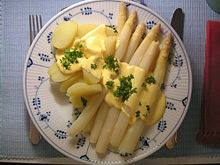
Typical serving of asparagus with Hollandaise sauce and potatoes
Asparagus is very popular in the Netherlands, Spain, France, Poland, Belgium, Germany, Austria, Turkey, Italy, and Switzerland, and is almost exclusively white;[citation needed] if not, it is specified by the local language term for "green asparagus". White asparagus is the result of applying a blanching technique while the asparagus shoots are growing. To cultivate white asparagus, the shoots are covered with soil as they grow, i.e. earthed up; without exposure to sunlight, no photosynthesis starts, and the shoots remain white. Compared to green asparagus, the locally cultivated so-called "white gold" or "edible ivory" asparagus, also referred to as "the royal vegetable",[17] is believed to be less bitter and much more tender. Freshness is very important, and the lower ends of white asparagus must be peeled before cooking or raw consumption.
Only seasonally on the menu, asparagus dishes are advertised outside many restaurants, usually from late April to June. For the French style, asparagus is often boiled or steamed and served with Hollandaise sauce, melted butter or olive oil, Parmesan cheese, or mayonnaise.[27] Tall, narrow asparagus cooking pots allow the shoots to be steamed gently, their tips staying out of the water.
During the German Spargelsaison or Spargelzeit ("asparagus season" or "asparagus time"), the asparagus season that traditionally finishes on 24 June, roadside stands and open-air markets sell about half of the country's white asparagus consumption.[28]

German botanical illustration of asparagus
Cultivation
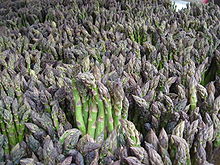
Green asparagus for sale in New York City
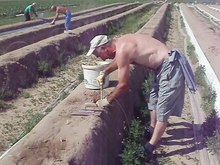 Play media
Play mediaHarvest of white asparagus in Hockenheim, Germany
Since asparagus often originates in maritime habitats, it thrives in soils that are too saline for normal weeds to grow. Thus, a little salt was traditionally used to suppress weeds in beds intended for asparagus; this has the disadvantage that the soil cannot be used for anything else. Some places are better for growing asparagus than others. The fertility of the soil is a large factor. "Crowns" are planted in winter, and the first shoots appear in spring; the first pickings or "thinnings" are known as sprue asparagus. Sprue has thin stems.[29]
A breed of "early season asparagus" that can be harvested two months earlier than usual was announced by a UK grower in early 2011.[30] This variety does not need to lie dormant and blooms at 7 °C (45 °F) rather than the usual 9 °C (48 °F).
Purple asparagus differs from its green and white counterparts in having high sugar and low fibre levels. Purple asparagus was originally developed in Italy, near the city of Albenga and commercialized under the variety name 'Violetto d' Albenga'.[31] Since then, breeding work has continued in the United States and New Zealand, creating the 'Pacific Purple' variety.[32]
Companion planting
Asparagus is said to be a useful companion plant for tomatoes, as the tomato plant repels the asparagus beetle. Asparagus may repel some harmful root nematodes that affect tomato plants.[33]
Commercial production

Asparagus output in 2005 shown as a percentage of the top producer (China)
100
10
1
The top asparagus importers (2013) were the United States (182,805 tonnes), followed by the European Union (external trade) (94,475 tonnes), and Canada (20,219 tonnes).[34]
China is by far the world's largest producer: in 2013 it produced 7,000,000 tonnes, followed by Peru with 383,144 tonnes and Mexico with 126,421 tonnes.[35] U.S. production was concentrated in California, Michigan, and Washington.[36][37]
The annual production for white asparagus in Germany is 57,000 tonnes (61% of consumer demand).[38]
When growing under tunnels, growers can increase the growth season. In Britain, it is estimated that the harvest season of asparagus grown under tunnels can be from February to November.[39][clarification needed]
Celebrations
The green crop is significant enough in California's Sacramento–San Joaquin River Delta region that the city of Stockton holds a festival every year to celebrate it; as do the neighboring villages of Shelby, Oceana County, Michigan, and Hart, Michigan, complete with a parade and asparagus queen. The two villages alternate each year as the host of the festival. The Vale of Evesham in Worcestershire is the largest producer within Northern Europe, celebrating with the annual British Asparagus Festival involving auctions of the best crop, an "Asparagus Run" modelled on the Beaujolais Run and a weekend "Asparafest" music festival.[40]
Many German cities hold an annual Spargelfest (asparagus festival) celebrating the harvest of white asparagus. Schwetzingen claims to be the "Asparagus Capital of the World", and during its festival, an Asparagus Queen is crowned. The Bavarian city of Nuremberg feasts a week long in April, with a competition to find the fastest asparagus peeler in the region. This usually involves generous amounts of the local wines and beers being consumed to aid the spectators' appreciative support.[41]
Helmut Zipner holds the world record in asparagus peeling.[42]
Vernacular names and etymology
A. officinalis is widely known simply as "asparagus", and may be confused with unrelated plant species also known as "asparagus", such as Ornithogalum pyrenaicum known as "Prussian asparagus" for its edible shoots.
The English word "asparagus" derives from classical Latin, but the plant was once known in English as sperage, from the Medieval Latin sparagus.[Note 2] This term itself derives from the Greek aspharagos or asparagos, and the Greek term originates from the Persian asparag, meaning "sprout" or "shoot". Asparagus was also corrupted in some places to "sparrow grass"; indeed, John Walker wrote in 1791 that "Sparrowgrass is so general that asparagus has an air of stiffness and pedantry".[43]
The name 'sparrow grass' was still in common use in rural East Anglia, England well into the twentieth century.[44]
In Turkish, asparagus is known as kuşkonmaz,[45] literally "[a] bird won't land [on it]", in reference to the shape of the plant.
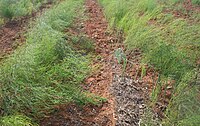
Asparagus in Mildura, Victoria, Australia
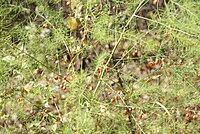
Mature native asparagus with seed pods in Saskatchewan, Canada
Effects on urine
The effect of eating asparagus on urine excreted afterwards has long been observed:
[Asparagus] cause a powerful and disagreeable smell in the urine, as everybody knows.
- — Treatise of All Sorts of Foods, Louis Lemery, 1702[46]
asparagus... affects the urine with a foetid smell (especially if cut when they are white) and therefore have been suspected by some physicians as not friendly to the kidneys; when they are older, and begin to ramify, they lose this quality; but then they are not so agreeable.
- — "An Essay Concerning the Nature of Aliments", John Arbuthnot, 1735[47]
A few Stems of Asparagus eaten, shall give our Urine a disagreable Odour...
- — "Letter to the Royal Academy of Brussels", Benjamin Franklin, c. 1781[48]
Asparagus "...transforms my chamber-pot into a flask of perfume."
- — Marcel Proust (1871–1922)[49]
Asparagus contains asparagusic acid. When the vegetable is digested, this chemical is broken down into a group of related sulfur-containing compounds.[50]
Debate exists about the universality of producing the sulfurous smell, as well as the ability to detect it. Originally, this was thought to be because some people digested asparagus differently from others, so some excreted odorous urine after eating asparagus, and others did not. In the 1980s, three studies from France,[51] China, and Israel published results showing that producing odorous urine from asparagus was a common human characteristic. The Israeli study found that from their 307 subjects, all of those who could smell "asparagus urine" could detect it in the urine of anyone who had eaten asparagus, even if the person who produced it could not detect it.[52] A 2010 study[53] found variations in both production of odorous urine and the ability to detect the odor, but that these were not tightly related. Most people are thought to produce the odorous compounds after eating asparagus, but the differing abilities of various individuals to detect the odor at increasing dilutions suggests a genetically determined specific sensitivity.[54][55][56]
In 2010, the company 23andMe published a genome-wide association study on whether participants have "ever noticed a peculiar odor when you pee after eating asparagus?"[57] This study pinpointed a single-nucleotide polymorphism (SNP) in a cluster of olfactory genes associated with the ability to detect the odor. While this SNP did not explain all of the difference in detection between people, it provides support for the theory that genetic differences occur in olfactory receptors that lead people to be unable to smell these odorous compounds.
Chemistry

Asparagus foliage turns bright yellow in autumn
Certain compounds in asparagus are metabolized to yield ammonia and various sulfur-containing degradation products, including various thiols and thioesters,[58] which give urine a characteristic smell.
Some[59] of the volatile organic compounds responsible for the smell are:[60][61]
- methanethiol
- dimethyl sulfide
- dimethyl disulfide
- bis(methylthio)methane
- dimethyl sulfoxide
- dimethyl sulfone
Subjectively, the first two are the most pungent, while the last two (sulfur-oxidized) give a sweet aroma. A mixture of these compounds form a "reconstituted asparagus urine" odor. This was first investigated in 1891 by Marceli Nencki, who attributed the smell to methanethiol.[62] These compounds originate in the asparagus as asparagusic acid and its derivatives, as these are the only sulfur-containing compounds unique to asparagus. As these are more present in young asparagus, this accords with the observation that the smell is more pronounced after eating young asparagus. The biological mechanism for the production of these compounds is less clear.[citation needed]
The onset of the asparagus urine smell is remarkably rapid while the decline is slower. The smell has been reported to be detectable 15 to 30 minutes after ingestion[63][64] and subsides with a half-life of approximately 4 hours.[65]
Gallery
Wild asparagus sauteed with garlic, naam plaa, and soy sauce
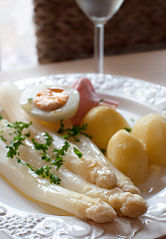
In the Netherlands and northern Germany, asparagus is often eaten with ham, boiled egg, potatoes, and a melted butter sauce.

Cream of asparagus soup
Three types of asparagus are on display, with white asparagus at the back and green asparagus in the middle. The plant at the front is Ornithogalum pyrenaicum, commonly called wild asparagus, and sometimes "bath asparagus".
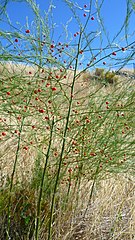
Asparagus officinalis next to Columbia River in East Wenatchee, Douglas County Washington
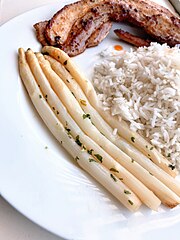
Asparagus served with bacon and rice
Notes
^ Latin velocius quam asparagi conquantur (or celerius quam asparagi cocuntur), ascribed to Augustus by Suetonius (The Lives of the Twelve Caesars, Book 2 (Augustus), para. 87). See List of Latin phrases (V).
^ abc Apparently around 1000 AD, the word "sparagus" appeared in an English text. See Brunning (June 2010), p. 6. – Brunning uses the term "in print", though no printing technique was used in England at the time. In the same sentence, she states that peasants often called it "sparrow grass", and further on mentions a 1667 diary in which Samuel Pepys bought a bundle of "sparrow grass" in Fenchurch Street, London.
References
^ The Plant List, Asparagus officinalis L.
^ "Asparagus officinalis L.". Plants of the World Online. Royal Botanic Gardens, Kew. Retrieved 2018-05-31..mw-parser-output cite.citation{font-style:inherit}.mw-parser-output q{quotes:"""""""'""'"}.mw-parser-output code.cs1-code{color:inherit;background:inherit;border:inherit;padding:inherit}.mw-parser-output .cs1-lock-free a{background:url("//upload.wikimedia.org/wikipedia/commons/thumb/6/65/Lock-green.svg/9px-Lock-green.svg.png")no-repeat;background-position:right .1em center}.mw-parser-output .cs1-lock-limited a,.mw-parser-output .cs1-lock-registration a{background:url("//upload.wikimedia.org/wikipedia/commons/thumb/d/d6/Lock-gray-alt-2.svg/9px-Lock-gray-alt-2.svg.png")no-repeat;background-position:right .1em center}.mw-parser-output .cs1-lock-subscription a{background:url("//upload.wikimedia.org/wikipedia/commons/thumb/a/aa/Lock-red-alt-2.svg/9px-Lock-red-alt-2.svg.png")no-repeat;background-position:right .1em center}.mw-parser-output .cs1-subscription,.mw-parser-output .cs1-registration{color:#555}.mw-parser-output .cs1-subscription span,.mw-parser-output .cs1-registration span{border-bottom:1px dotted;cursor:help}.mw-parser-output .cs1-hidden-error{display:none;font-size:100%}.mw-parser-output .cs1-visible-error{font-size:100%}.mw-parser-output .cs1-subscription,.mw-parser-output .cs1-registration,.mw-parser-output .cs1-format{font-size:95%}.mw-parser-output .cs1-kern-left,.mw-parser-output .cs1-kern-wl-left{padding-left:0.2em}.mw-parser-output .cs1-kern-right,.mw-parser-output .cs1-kern-wl-right{padding-right:0.2em}
^ ab "Asparagus officinalis". Flora Europaea. Royal Botanic Garden Edinburgh. Retrieved 19 May 2010.
^ "Asparagus officinalis". Euro+Med Plantbase Project. Botanic Garden and Botanical Museum Berlin-Dahlem. Archived from the original on 11 August 2011. Retrieved 19 May 2010.
^ "Asparagus officinalis". Germplasm Resources Information Network (GRIN). Agricultural Research Service (ARS), United States Department of Agriculture (USDA). Retrieved 19 May 2010.
^ Grubben, G.J.H.; Denton, O.A., eds. (2004). Plant Resources of Tropical Africa 2. Vegetables. PROTA Foundation, Wageningen; Backhuys, Leiden; CTA, Wageningen.
^ Diderot, Denis (2 November 2009) [1772]. "Asparagus". Encyclopedia of Diderot & d'Alembert. Retrieved 1 April 2015 – via Collaborative Translation Project, University of Michigan.
^ "Growing Asparagus". gardengrow.co.nz.
^ ab Blamey, M. & Grey-Wilson, C. (1989). Flora of Britain and Northern Europe.
ISBN 0-340-40170-2.
^ Stace, Clive; van der Meijden, Ruud (ed.); de Kort, Ingrid (ed.). "Asparagus prostratus (Asparagus, Wild)". Interactive Flora of NW Europe. ETI BioInformatics. Archived from the original on 23 September 2009. Retrieved 19 May 2010.CS1 maint: Extra text: authors list (link)
^
"Asparagus prostratus". Germplasm Resources Information Network (GRIN). Agricultural Research Service (ARS), United States Department of Agriculture (USDA). Retrieved 19 May 2010.
^ "The French Chef; Asparagus From Tip to Butt". The Julia Child Project. WGBH Open Vault. April 25, 1966. Retrieved September 16, 2016.
^ Brunning, Pam (June 2010). "Asparagus – Liliaceae–Asparagacease" (Pdf). Food & Wine (103). Retrieved 26 August 2011.
^ abc "Over asperge – Oudheid" (in Dutch). Stichting Afzetbevordering Asperges. Retrieved 26 August 2011.
^ Vaughan, John Griffith; Geissler, Catherine Alison; Nicholson, Barbara (1997). The New Oxford Book of Food Plants. Oxford University Press.
^ "What's that smell?". Focus on food safety. 2013-03-26. Retrieved 6 October 2014.
^ ab "Wit goud en koningin der groente: vorstelijke asperges" (in Dutch). Infoyo (web publisher), Netherlands. 20 May 2009. Archived from the original on 19 January 2012. Retrieved 26 August 2011.
^ "Growing Asparagus in the Home Garden; Section on harvesting" (PDF). Purdue University Cooperative Extension Service. p. 2. Retrieved 31 January 2014.
^ Snyder, Harry. (1908). "Human Foods and their Nutritive value". The MacMillan Company.
^ "Nutrition Facts".
^ USDA Agricultural Research Service Data section 11 (pg 61) Archived 13 January 2012 at the Wayback Machine.
^ David Lissner (2010-04-21). "Dining Chicago".
^ Salad Recipe Archived 19 July 2010 at the Wayback Machine.
^ "Ingredients – Asparagus". DrGourmet.com. Retrieved 20 July 2011.
^ Oxford Times: "Time to glory in asparagus again". Archived 7 September 2009 at the Wayback Machine.
^ "Page Redirection".
^ "Choisissez une recette de Salsifis" (in French). Recettes de Cuisine TV. Retrieved 26 August 2011. (Salsifis is French for asparagus.)
^ Evans, Stephen (2012-04-21). "Asparagus, royalty and the joys of seasonal eating". BBC News. Retrieved 22 April 2012.
^ "BBC – Food – Glossary – 'S'". BBC Online. Retrieved 8 June 2007.
^ "New breed of early asparagus hits the shelves". The Daily Telegraph. 19 March 2011. Retrieved 20 March 2011.
^ Raymond, Francine (21 May 2014). "Asparagus: this season's hottest shades to grow". The Telegraph. Retrieved 21 May 2017.
^ "Introducing the latest superfood... Purple asparagus". dailymail.co.uk. 26 April 2007. Retrieved 21 May 2017.
^ "Plants for a Future".
^ "Food and Agriculture Organisation Statistics (FAOSTAT)". Retrieved 3 May 2016.
^ "Food and Agriculture Organisation Statistics (FAOSTAT)". Archived from the original on 6 September 2015. Retrieved 3 May 2016.
^ "Food and Agriculture Organisation Statistics (FAOSTAT)". Archived from the original on 7 November 2007. Retrieved 11 November 2007.
^ USDA (January 2006). Vegetables 2005 Summary. National Agricultural Statistics Service.
^ Spence, Molly. "Asparagus: The King of Vegetables". German Agricultural Marketing Board. Archived from the original (DOC) on 13 October 2007. Retrieved 26 February 2007.
^ "U.K. grower creates asparagus market – Vegetable Growers News". Vegetable Growers News.
^ "British Aparagus Festival".
^ "Official internet portal of the City of Nuremberg".
^ http://www.csmonitor.com/2008/0514/p17s01-hfgn.html?page=2 Buried treasure: white asparagus
^ Walker, John (1806). A Critical Pronouncing Dictionary, and Expositor of the English Language. Retrieved 18 November 2016.
^ Ewart Evans, George "Ask the Fellows who Cut the Hay"
^ "How to consume asparagus" (in Turkish). 1organik.com. Retrieved 21 May 2017.
^ McGee, Harold (2004). "6". McGee on Food and Cooking. Hodder and Stoughton. p. 315. ISBN 978-0-340-83149-6.
^ Arbuthnot J (1735). An Essay Concerning the Nature of Aliments 3rd ed. London: J. Tonson. pp. 64261–262.
^ Franklin, Benjamin (c. 1781). "Letter to the Royal Academy of Brussels".
[permanent dead link]
^ From the French "[...] changer mon pot de chambre en un vase de parfum", Du côté de chez Swann, Gallimard, 1988.
^ Stromberg, Joseph. "Why Asparagus Makes Your Urine Smell". smithsonianmag.com.
^ C. RICHER1, N. DECKER2, J. BELIN3, J. L. IMBS2, J. L. MONTASTRUC3 & J. F. GIUDICELLI (May 1989). "Odorous urine in man after asparagus". Br. J. Clin. Pharmacol. 27 (5): 640–1. doi:10.1111/j.1365-2125.1989.tb03431.x. PMC 1379934. PMID 2757887.CS1 maint: Uses authors parameter (link)
^ S. C. MITCHELL (May 1989). "Asparagus and malodorous urine". Br. J. Clin. Pharmacol. 27 (5): 641–2. doi:10.1111/j.1365-2125.1989.tb03432.x. PMC 1379935. PMID 2757888.
^ Pelchat, M. L.; Bykowski, C.; Duke, F. F.; Reed, D. R. (2010). "Excretion and Perception of a Characteristic Odor in Urine after Asparagus Ingestion: a Psychophysical and Genetic Study". Chemical Senses. 36 (1): 9–17. doi:10.1093/chemse/bjq081. PMC 3002398. PMID 20876394.
^ "The scientific chef: asparagus pee". The Guardian. 23 September 2005. Archived from the original on 4 May 2007. Retrieved 21 April 2007.
^ Hannah Holmes. "Why Asparagus Makes Your Pee Stink". Discover.com. Archived from the original on 29 February 2008.
^ Lison M, Blondheim SH, Melmed RN (1980). "A polymorphism of the ability to smell urinary metabolites of asparagus". Br Med J. 281 (6256): 1676–8. doi:10.1136/bmj.281.6256.1676. PMC 1715705. PMID 7448566.
^ Eriksson N, Macpherson JM, Tung JY, Hon LS, Naughton B, Saxonov S, Avey L, Wojcicki A, Pe'er I, Mountain J (2010). Gibson G, ed. "Web-Based, Participant-Driven Studies Yield Novel Genetic Associations for Common Traits". PLoS Genet. 6 (6): e1000993. doi:10.1371/journal.pgen.1000993. PMC 2891811. PMID 20585627.
^ White RH. (1975). "Occurrence of S-methyl thioesters in urines of humans after they have eaten asparagus". Science. 189 (4205): 810–11. doi:10.1126/science.1162354. PMID 1162354.
^ Pelchat, M. L.; Bykowski, C.; Duke, F. F.; Reed, D. R. (26 July 2010). "Excretion and Perception of a Characteristic Odor in Urine after Asparagus Ingestion: a Psychophysical and Genetic Study". Chemical Senses. 36 (1): 9–17. doi:10.1093/chemse/bjq081. PMC 3002398. PMID 20876394. Retrieved 31 January 2014.
^ Waring RH, Mitchell SC, Fenwick GR (1987). "The chemical nature of the urinary odour produced by man after asparagus ingestion". Xenobiotica. 17 (11): 1363–1371. doi:10.3109/00498258709047166. PMID 3433805.
^ Mitchell S.C. (2001). "Food idiosyncrasies: beetroot and asparagus". Drug Metabolism and Disposition. 29 (4): 539–543. PMID 11259347.
^ Nencki, Marceli (1891). "Ueber das vorkommen von methylmercaptan im menschlichen harn nach spargelgenuss". Arch. Exp. Pathol. Pharmakol. 28 (3–4): 206–209. doi:10.1007/BF01824333.
^ Somer, E. (14 August 2000). "Eau D'Asparagus". WebMD. Archived from the original on 21 August 2006. Retrieved 31 August 2006.
^ Research completed and verified by Dr. R. McLellan from the University of Waterloo.
^ van Hasselt, J. G. Coen; Elassaiss-Schaap, Jeroen; Ramamoorthy, Anuradha; Sadler, Brian M.; Kasichayanula, Sreeneeranj; Edwards, Yin; van der Graaf, Piet H.; Zhang, Lei; Wagner, John A. "The proof is in the pee: Population asparagus urinary odor kinetics". PAGE. Abstracts of the Annual Meeting of the Population Approach Group in Europe. 25. Retrieved 2016-07-07.
External links
| Wikimedia Commons has media related to Asparagus officinalis. |
Wikibooks Cookbook has a recipe/module on
|
Wikisource has the text of the 1911 Encyclopædia Britannica article Asparagus. |
- Kew Species Profile: Asparagus officinalis (garden asparagus)
- PROTAbase on Asparagus officinalis
Asparagus officinalis – Plants for a Future database entry
"World Asparagus Situation and Outlook" (PDF). Archived from the original (PDF) on 2012-10-18. (55.0 KB) – 2005 USDA report
Asparagus Production Management and Marketing at the Library of Congress Web Archives (archived 2002-09-17) – commercial growing (OSU bulletin)





